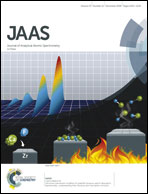A UV digital micromirror spectrometer for dispersive AFS: spectral interference in simultaneous determination of Se and Pb
Abstract
Hollow cathode lamps (HCLs) are excitation light sources commonly used in hydride generation atomic fluorescence spectrometry (HG-AFS). There are obvious Pb interfering lines at 217.0 nm, 261.3 nm, and 283.3 nm in the atomic fluorescence spectrum excited by Se HCLs. This will induce erroneously measured results especially when using the non-dispersive detection method when Se and Pb are detected simultaneously. To solve the spectral interference caused by Se HCLs, in this paper, a UV digital micromirror spectrometer using a digital micromirror device (DMD) as a spatial light modulator, a grating as a spectroscope, and a photomultiplier tube (PMT) as a detector is designed for dispersive atomic fluorescence spectrometry. In addition, a modified DMD with a cover window made of Corning HPFS® 7980 standard grade fused silica was used to provides a higher transmittance of 180–320 nm. The most attractive features of this UV digital micromirror spectrometer are its simple structure, high sensitivity, no macroscopic moving parts, and rapid spectral analysis (0.419 s per spectrum). After optimizing DMD and PMT control parameters, the effects of the chemical generation system (K3Fe(CN)6, KBH4, and HCl) are investigated. The atomic fluorescence spectra of Se and Pb are obtained, and the detection limits of the analytical lines are discussed. The feasibility of the present method is confirmed by simultaneous detection of Se and Pb using water samples (GSBZ50031-94 and GSB07-1183-2000) and multi-element standard solution (GBW(E)080669) as reference materials. This study demonstrates the potential of the proposed spectrometer for dispersive HG-AFS, which appropriately reduces the purity requirements of the light source and the spectral interference from light sources. It is also applicable to simultaneous detection using multi-element HCLs or continuous light sources.



 Please wait while we load your content...
Please wait while we load your content...